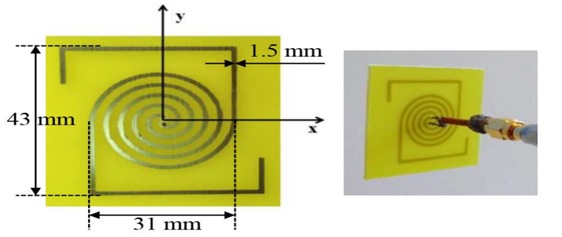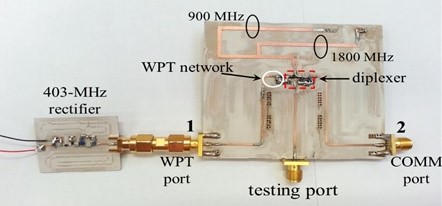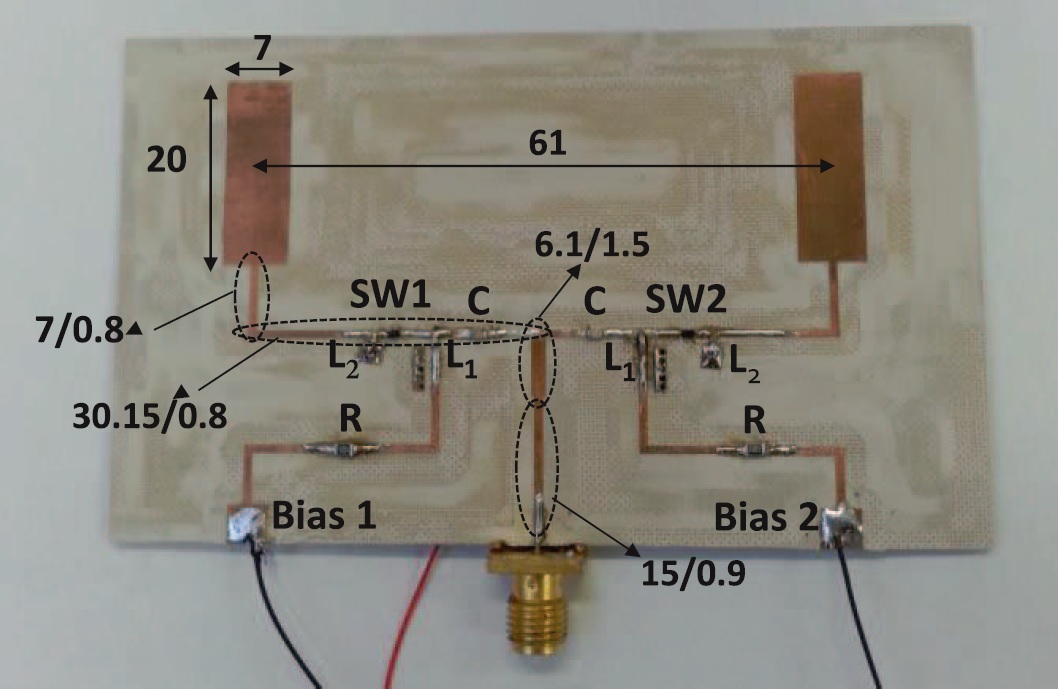Research Activities
Research Activities
The Laboratory research activity consists of Computer Aided Design of RF integrated nonlinear radiating subsystems. The Laboratory guides the following research themes:
-
A NOVEL INTEGRATED UWB–UHF ANTENNA FOR LOCALIZATION AND ENERGY HARVESTING
A novel antenna combining both UWB and UHF bands. Proposed for next-generation passive RFID tags, performing communication and localization through UWB technology and efficient energy harvesting in the UHF band, is also designed to keep compatibility with previous tags generations. The UWB communication is deployed by means of an Archimedean spiral topology, while energy harvesting at UHF is obtained by suitably extending the spiral outer arms, thus realizing a meandered dipole, without affecting the UWB behavior. This solution allows a direct connection to future integrated UWB-UHF chips, to standard RFID chips, or to a diplexer for suitably combining the UWB and the UHF functionalities.
• Journal Reference

-
A UHF NEAR-FIELD LINK FOR PASSIVE SENSING IN INDUSTRIAL WPT SYSTEMS
An innovative nonconventional exploitation of a self-resonant capacitive near-field link at UHF, for data communication, to be combined in a compact wireless power transfer (WPT) system has been investigated. At UHF, an increased channel transfer efficiency is made possible by exploiting two faced auto-resonant structures, such as split-ring resonators, one at each far-end side of the link. This network is then used in a passive sensing system, based on a smart exploitation of the dc-power dc-load relationship of a standard RF identification (RFID) rectifier, to convert the data of a remote sensor, representing the system variable load. The entire sensing system is first optimized by means of nonlinear circuit and electromagnetic simulations.
• Journal Reference

-
SEAMLESS EXPLOITATION OF CELL-PHONE ANTENNAS FOR NEAR-FIELD WPT
This is a solution for portable devices to exploit their existing communication antennas (i.e. 900/1800 MHz ) for bi-directional near-field wireless re-charging (433MHz), without compromising their far-field properties. Definition of the equivalence between electromagnetic structures and lumped elements circuit models has been defined.
• Journal Reference
Prototype has been realized and performances are investigated at different distances when facing two identical dual-band printed monopole. A proof-of-concept prototype has been realized and characterized.

-
LOAD- AND POSITION INDEPENDENT MOVING WPT SYSTEM
A complete (dc-to-dc) inductive wireless power transfer (WPT) system for industrial moving applications has been investigated. The system operates at 6.78 MHz and delivers up to 150 W to a load moving along a linear path, providing a quasi-constant dc output voltage. Through optimization of both transmitting and receiving coils, a constant coupling factor has been obtained in an inductive link. The work in this paper is foreseen as a design solution for a high-efficient, maintenance-free, and reliable WPT system for powering sliders and mass movers in industrial automation plants.
• Journal Reference

-
ARTIFICIAL NEURAL NETWORK DESIGN OF A MILLIMETRE-WAVE SLOTTED PATCH MULTI-ANTENNA CONFIGURATION FOR 5G SCENARIOS
This study addresses the modelling of a dual band (28 and 38 GHz), circularly polarised slotted-patch-antenna for highly demanded millimetre wave multi-input multi-output (MIMO)-systems in fifth generation (5G) networks. A computer-aided-design model is derived by means of an artificial neural network (ANN) which allows obtaining the physical dimensions of a single-fed antenna, satisfying both near- and far-field goals, without resorting to time-consuming electromagnetic simulation and allowing, for the first time, to carry out optimisations of strategic importance for future 5G non-linear-radiating-systems, especially operating at millimetre wave, directly addressing their far-field behaviour. The model performance is validated by some examples and measurement results.
• Journal Reference

-
TIME-MODULATION OF LINEAR ARRAYS FO REAL-TIME RECONFIGURABLE WIRELESS POWER TRANSMISSION
A smart wireless power transmission method, based on a two-step procedure, exploiting real-time beaming of time-modulated arrays has been investigated. The sideband radiation phenomenon, which is usually a drawback of these radiating systems, is favorably used for intentional wireless power transfer (WPT): in a first step to precisely localize the tag to be powered and in the second one to perform directive WPT. Experiment of the first step is carried out in a real indoor environment at 2.45 GHz: a TI MSP430 drives a Schottky-diode-based network to provide proper modulated RF excitations of the array elements. Measurements show that the system is able to select tags to be energized randomly distributed in a 100 -scanning range.
• Journal Reference

Equipment
-
Instruments
• RF signal generator: Systron Donner 1710B-S1087 (10MHz-8GHz)
• RF signal generator: Hitite HMC-T2100 (10MHz-20GHz)
• Spectrum analyzer: Agilent N1996A (100kHz-6GHz)
• Broadband antenna: TDK Horn (1-18GHz)
• 2 DC signal generators: Agilent E3631A
• Oscilloscope: Agilent DSO-X 3024A
• Vector Network Analyzer (VNA): FieldFox N9923A (6GHz)
• Prototypig machine: PROTOMAT E33
• Horn antenna HRN0118 (1GHz-18GHz) -
Softwares
• 3D electromagnetic simulator: CST Microwave Studio
• CAD circuital and electromagnetic simulator: ADS (Advanced Design System)
• Circuit simulator: AWR Microwave Office
• Circuit simulator developed by the DEI research group: NONLIN
Teaching Activities
RFCAL spaces are shared with the educational Lab of Antenna Systems. This Lab is devoted to the broadband characterization of planar antennas, realized in the research activitiies, by means of scattering parameters and radiated field mesurements. The educational activity is carried on in the courses:
-
34801 - Bioelectromagnetism (2nd cycle) - 6 cfu
❮ 2009-2018 ❯
-
35112 - Autonomous RF Sistems (2nd Cycle) - 6 cfu
❮ 2010-2018 ❯
-
82072 - Antennas for Wireless Systems M - 6 cfu
❮ 2016-2018 ❯
-
82086 - Circuit Design for Wireless Systems M - 6 cfu
❮ 2017-2018 ❯
-
73118 - Systems and Optical Wirless Circuits T - 1 (Module 3)
❮ 2017-2018 ❯
-
07941 - Electromagnetic Fields (Module 2)
❮ 2017-2018, 2009-2013 ❯
-
35158 - Advanced electromagnetic transmission techniques and devices M (Module 2)
❮ 2004-2016 ❯
-
37114 - Electromagnetic Technologies for Link Design M (Module 2)
❮ 2010-2016 ❯
-
60986 - Free and Guided eletromagnetic Propagation (Module 2)
❮ 2013-2016 ❯
-
75494 - Energy-Aware Wireless Circuits And Systems M - 3 cfu
❮ 2015-2016 ❯
-
37127 - Electromagnetic Modelling of Rf Subsystems M - 3 cfu
❮ 2011-2015 ❯
-
34903 - Radio Frequency Circuits Design M - 6 cfu
❮ 2010-2011 ❯
-
17974 - Electromagnetic Fields L-A - 6 cfu
❮ 2007-2010 ❯
-
42053 - Technologies for Radio Frequency Systems - 6 cfu
❮ 2007-2010 ❯
-
41584 - Radio Frequency Circuits Design (Graduate Course) - 6 cfu
❮ 2009-2010 ❯
-
41480 - Microwave Technique L-A - 3 cfu
❮ 2007-2008 ❯